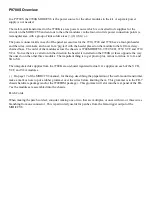
28
Signal Display
8 Measurements
There are two different types of measurements on signals:
cursor measurements and automatic measurements. All
measurements are stored in a buffer memory that is larger
than the display memory. The integrated hardware counter
shows the frequency and period duration for the selected
input.
8 .1 Cursor Measurements
The measurement option that is most frequently used with
an oscilloscope is the cursor measurement. Depending on
the measurement type up to three markers are available. To
control cursor measurements, you may use the keys CUR-
SOR MEASURE and KEYPAD as well as the universal knob.
The menu CURSOR MEASURE allows you to select cursor-
based measurements for an activated signal source on the
oscilloscope. The measurement type can be defined in the
menu that opens when you press the CURSOR MEASURE
key.
Following measurement types can be selected:
VOLTAGE:
This mode provides two cursors to
measure three different voltages. The values
V1 and V2 correspond to the voltage between
the zero base line of the selected signal and the current
position of the first or second cursor. The value ΔV corres
-
ponds to the amount of voltage between the two cursors.
TIME:
This mode provides two cursors to
measure three different times and an equivalent
frequency. The values t1 and t2 correspond to
the time between the trigger and the current position of
the first or second cursor. The value Δt corresponds to the
amount of time between the two cursors.
RATIO X:
This mode provides three cursors to
measure a ratio in X direction (e.g. a duty ratio)
between the first two cursors and the first and
the third cursor. The measurement values are displayed in
four different formats (floating point, percent, degrees and
radians).
RATIO Y:
This mode provides three cursors
to measure a ratio in Y direction (e.g. an
overshoot) between the first two cursors and
the first and the third cursor. The measurement values
are displayed in two different formats (floating point and
percent).
COUNT:
This mode provides three cursors to
count signal changes that exceed the threshold
within a specific interval. The interval may be
set by using the first two cursors and the
threshold may be
set by using the third cursor. The measurement values are
displayed in four different formats (number of rising and
falling slopes and number of positive and negative pulses).
PEAK VALUES:
This mode provides two
cursors to measure the minimum and the maxi-
mum voltage of a signal within the interval set
by using both cursors. The values Vp- and Vp+
correspond to the minimum and the maximum voltage.
The peak value (Vpp) corresponds to the amount of vol-
tage between the minimum and maximum value.
RMS, MEAN, STANDARD DEVIATION:
This
mode provides two cursors to measure the
effective value (RMS – Root Mean Square), the
mean value and the standard deviation within the interval
set by using both cursors.
DUTY RATIO:
This mode provides three
cursors to determine the duty ratio between
the two horizontal cursors. The third cursor is
used to specify the threshold at which the duty ratio is
measured.
BURST WIDTH:
This mode determines the
duration of burst from the first edge to the last
edge (Bst).
RISE TIME 90%:
This mode provides two cur-
sors to measure the rise and fall time of the first
rising slope in the displayed view of the screen
within the time span set by the cursors. The rise time iden-
tifies the time in which the signal rises from 10% to 90% of
its amplitude.
RISE TIME 80%:
This mode provides two cur-
sors to measure the rise and fall time of the first
rising slope in the displayed view of the screen
within the time span set by the cursors. The rise time iden-
tifies the time in which the signal rises from 20% to 80%
of its amplitude.
V-MARKER:
This mode pro-
vides two cursors to measure
three different voltages and
a time. The values V1 and V2 correspond to the voltage
between the zero base line of the selected curve and the
current position of the first or second cursor. The value ΔV
corresponds to the amount of voltage between the two
cursors. The value Δt corresponds to the amount of time
between the two cursors.
CREST FACTOR:
The crest factor (peak-to-average ratio)
is calculated from the maximum value divided by the RMS
value of the waveform (Crest).
To move cursors, press the universal knob in the CURSOR/
MENU section and position the cursor by turning the univer-
sal knob. The measurement types have the following func-
tions. The measurement results are displayed at the bottom
of the screen. If “n/a” is displayed, the measurement is not
applicable to the signal. For instance, this may be the case
for a voltage measurement on a POD because only logic sta-
















































